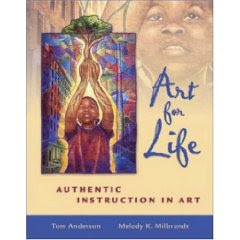Personalized Responses
- Motivate student's personal experiences
- Involve student's from differing cultural backgrounds, but do not stereotype cultures by expecting students to express particular preferences
Hands-on art activities
- Murals promote social intelligence
- Promote cultural understanding through puppets and dioramas
- Discuss sociopolitical issues when doing artwork in the style of another culture
Drawing still-life arrangements about a culture
- Borrow items from a children's museum
- Ask parents to loan items from their culture
Using models or speakers
- When studying a region, invite someone from that region to come and talk while wearing an ethnic costume
- Invite parents or guests with interesting occupations or hobbies
- Have students take turns wearing special hats or clothing
Sketching trips
- Can help students gain insight into issues of historic preservation, trade, technological innovation, and community growth
- Discuss background or sociopolitical issues that you want students to understand
- While at the site, point out aesthetic qualities
Using art reproductions
- Use hypothesizing, evaluating, and synthesizing when discussing reproductions
- Use posters, postcards, or photographs
A Danger of Social Studies/Art Integration
avoid stereotypes and look-alike art projects
Social Studies Disciplines
Anthropology - the study of a people's symbols
- It is disrespectful to emphasize just one aspect of a group's culture
- It is not helpful to exoticise a culture or people
- Do not homogenize many national groups into one (i.e. lumping Puerto Ricans, Mexican-Americans, and Cubans into a single category of Latino or Hispanic)
Economics/Vocations - deals with both the structures that exist to provide jobs and services and also with the distribution of wealth
Geography - have students compare geographic areas including differences in climate, transportation, foods, customs, and home architecture
History - make history vivid through art projects
Political science and law-related education
- Law-related education deals with concepts such as equality, fairness, honesty, justice, power, property, responsibility, and tolerance
- Include issues such as family law (i.e. beatings), community-safety law (i.e. bike helmets), and consumer law (i.e. shoplifting)
- Political science is concerned with examining rules, both good and bad, and taking the rights of others into account
Psychology - concerned with how an individual perceives the world or behaves based on those perceptions
- Use art to build self-respect and positive self-concept
- Celebrate individual differences through art
Sociology - the study of how people function in groups
- Encourage students to think about such concepts as norms, society, values, competition, status, and change
- Use art reproduction to discuss sociological issues
Multicultural Understanding through Art - we can help children to understand and acquire the shared knowledge, beliefs, and attitudes common to both our nation's culture and their specific group
Multiculturalism in the postmodern art world
- Recently art has moved away from abstract art elements and toward exploring social, political, and environmental world problems through combining historical and popular images and new mixed-media techniques
Multiculturalism through a thematic approach
- Focuses on cultural differences and commonalities through exploration of concepts such as adaptation, survival, environment, time, space, and motion
- In teaching thematic units, relate material to the students' own personal experiences
Multiculturalism using contestable issues
- Another approach is to use issues about which students can debate






No comments:
Post a Comment